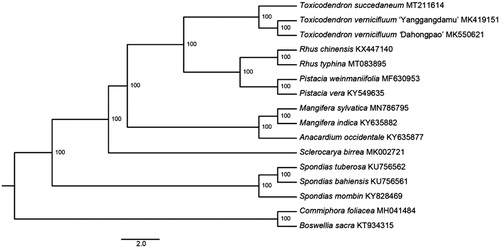Abstract
Toxicodendron succedaneum (L.) Kuntze is a deciduous and dioecious tree species in the family Anacardiaceae with important economic values. In this study, we sequenced and analyzed the complete chloroplast (cp) genome of T. succedaneum. The circular genome is 159,710 bp in size, and presents a quadripartite structure including two copies of inverted repeat (IR) regions of 26,524 bp, one large single-copy (LSC) region of 87,622 bp, and one small single-copy (SSC) region of 19,040 bp. It encodes a total of 113 unique genes, including 80 protein-coding genes, 29 tRNA genes, and four rRNA genes. Phylogenetic analysis based on 16 cp genome sequences revealed that the genus Toxicodendron is closely related to Pistacia and Rhus, and T. succedaneum was most closely related to T. vernicifluum.
Toxicodendron succedaneum (L.) Kuntze is a deciduous and dioecious tree species in the sumac family, Anacardiaceae. It is broadly distributed in the warm temperate zone across China, Japan, Indochina, Malaysia, and India (Hiraoka et al. Citation2018). As an important commercial arbor species, T. succedaneum can provide us with the raw lacquer, an excellent adhesive and painting material used to make lacquerware. In Japan, fruits of the species are collected to extract sumac wax, a raw material of traditional Japanese candles (Hiraoka et al. Citation2018). In Australia and New Zealand, T. succedaneum is planted as an ornamental plant for its beautiful autumn foliage. Recently, the complete chloroplast (cp) genome of Chinese lacquer tree (T. vernicifluum) has been reported (Zhong et al. Citation2019; Wang et al. Citation2020). However, plastid genome sequences of most Toxicodendron species remain unknown. In this study, we sequenced and analyzed the complete cp genome of T. succedaneum based on Illumina paired-end sequencing data.
Healthy and fresh leaves of T. succedaneum were collected from an adult tree growing at the Dongpingshang Village, Yuanhou Town, Chishui City, Zunyi City, Guizhou Province, China (28.28°N, 105.85°E). The voucher specimen of the individual (accession number LW190704001) was stored at the Herbarium of Nanjing Forestry University (HNFU). Total DNA extraction and whole genome sequencing on the Illumina Hiseq X Ten platform were conducted by Nanjing Genepioneer Biotechnologies Inc. (Nanjing, China). A total of 22,283,876 clean reads were used for the de novo assembly with NOVOplasty 2.7.2 (Dierckxsens et al. Citation2016). Gene annotation was performed using the CpGAVAS pipeline (Liu et al. Citation2012).
The complete cp genome of T. succedaneum (GenBank accession number MT211614) is a circular molecule of 159,710 bp in size, and presents a quadripartite structure including two copies of the IR region (26,524 bp), one LSC region (87,622 bp), and one SSC region (19,040 bp) . The overall GC content was 37.86%, while the corresponding values of the LSC, SSC, and IR regions were 35.97%, 32.50%, and 42.92%, respectively. The cp genome encoded a total of 134 genes, of which 113 were unique and 21 were duplicated in the IR regions. The 113 unique genes contained 80 protein-coding genes, 29 tRNA genes, and four rRNA genes. Nineteen genes contained introns, 16 of which (nine protein-coding genes and seven tRNA genes) contained one intron, and three of which (rps12, ycf3, and clpP) contained two introns.
To identify the phylogenetic position of T. succedaneum, we reconstructed a maximum-likelihood (ML) tree using cp genome sequences of 14 Anacardiaceae species and two outgroups from Burseraceae. Four locally collinear blocks (LCBs) were identified and a matrix of 85,249 bp was generated by the HomBlocks pipeline (Bi et al. Citation2018). The maximum likelihood analyses were performed with RaxmlGUI 1.5b1 (Silvestro and Michalak Citation2012). The GTRGAMMA model was selected for all the LCBs, and branch support values were estimated for each node based on 1,000 samples for rapid bootstrap. Our results indicated that Toxicodendron is closely related to Pistacia and Rhus, and T. succedaneum was most closely related to T. vernicifluum with 100% bootstrap support ().
Disclosure statement
No potential conflict of interest was reported by the authors.
Data availability
The complete chloroplast genome sequence of Toxicodendron succedaneum is deposited in the GenBank database under the accession number MT211614.
Additional information
Funding
References
- Bi G, Mao Y, Xing Q, Cao M. 2018. HomBlocks: a multiple-alignment construction pipeline for organelle phylogenomics based on locally collinear block searching. Genomics. 110(1):18–22.
- Dierckxsens N, Mardulyn P, Smits G. 2016. NOVOPlasty: de novo assembly of organelle genomes from whole genome data. Nucleic Acids Res. 45:18.
- Hiraoka Y, Tamaki I, Watanabe A. 2018. The origin of wild populations of Toxicodendron succedaneum on mainland Japan revealed by genetic variation in chloroplast and nuclear DNA. J Plant Res. 131(2):225–238.
- Liu C, Shi L, Zhu Y, Chen H, Zhang J, Lin X, Guan X. 2012. CpGAVAS, an integrated web server for the annotation, visualization, analysis, and GenBank submission of completely sequenced chloroplast genome sequences. BMC Genomics. 13:715.
- Silvestro D, Michalak I. 2012. RaxmlGUI: a graphical front-end for RAxML. Org Divers Evol. 12(4):335–337.
- Wang L, He N, Li Y, Fang YM, Zhang FL. 2020. Complete chloroplast genome sequence of Chinese lacquer tree (Toxicodendron vernicifluum, Anacardiaceae) and its phylogenetic significance. Biomed Res Int. 2020:9014873,.
- Zhong Y, Zong D, Zhou A, He X, He C. 2019. The complete chloroplast genome of the Toxicodendron vernicifluum cv. Dahongpao, an elite natural triploid lacquer tree. Mitochondrial DNA B. 4(1):1227–1228.

